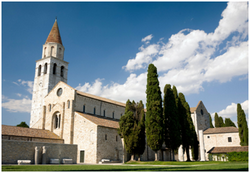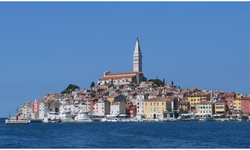
Location
A city between karst lands and sea
Trieste is a city and seaport in northeastern Italy. Its province is a narrow strip of Italian territory, lying between the Adriatic Sea and Slovenia, which lies almost immediately south and east of the city. Trieste is located at the head of the Gulf of Trieste and throughout history it has been influenced by its location at the crossroads of Latin, Slavic, and Germanic cultures. In 2009, it had a population of about 205,000 and it is the capital of the autonomous region Friuli-Venezia Giulia and the Province of Trieste.
Trieste is an international city, suspended between a glorious past of "Little Vienna on the Sea" and the present cosmopolitan city. From the Audace pier to the old Lanterna, there is a succession of sails, antique shop window displays, shops and beautiful buildings: in the distance, one can glimpse the white profile of Miramare, the romantic castle of Maximilian and Charlotte of Habsburg. A journey of discovery of the city's history, literature and art, from the Roman era to medieval wonders, to the Habsburg splendor. The wealth of architectural styles in the palaces in Trieste is remarkable: Neoclassical, Art Nouveau, Eclectic and Baroque, coexisting in a harmonious blend with Roman remains (Roman Theatre, Forum and Basilica), the Romanic San Giusto Cathedral and San Silvestro churches, the fifteen century San Giusto Castle. Memories and images of the past live on in the streets, from the narrow alleys that wind through the old city centre with their picturesque houses and ruined walls to the wide central streets that cross the new part of town with its elegant neo-classical buildings.
Coffee is one of the flagship products of Trieste. A Free Port for the importation of coffee since 1719, the port of Trieste is the largest in the Mediterranean for the trade of coffee: the beans that arrive here are not only intended for local coffee roasters but also for those all around the world. However, coffee in Trieste is also in rhythm with literature: many and beautiful are the literary cafes, which are historical premises with retro charm, frequented by poets and writers such as James Joyce, Italo Svevo, and Umberto Saba. Taking a coffee break in one of the historical cafes of Trieste is a ritual that is absolutely not to be missed and whose appeal has spread even through word of mouth. Would you like to know what a gocciato or a taste of a capo in b is? Then you must come to Trieste because you will only find out here…
Trieste is also a mixture of religions: this is evident as soon as you arrive in the city, which, for many centuries, has (amongst others) a Greek Orthodox Church, a Serbian Orthodox Church, a Synagogue, a Lutheran Evangelical Church and, the oldest of all, a Swiss Evangelical Church.
Trieste means love of the sea too: people here love going to the sea, and the beach resorts - or 'bagni', in local slang - are frequented all the year round, for sunbathing, swimming or just strolling. The International sailing regatta “Barcolana” attracts 2000 participants from all over the world on the second Sunday of October.
At the back of Trieste, the Karst plateau with a natural landscape of great beauty scattered with typical villages and natural caves.
Trieste is increasingly making itself known as “the city of science”. The town’s scientific tradition dates back to 1753, and it consolidated in the 20th century. Under Maria Theresa of Habsburg, the Jesuits instituted the School of Astronomy and Navigation, from which the Astronomical Observatory, the Thalassographic Institute (now ISMAR of Research Council of Italy ) and the Geophysical Observatory (now OGS - Istituto Nazionale di Oceanografia e di Geofisica Sperimentale) developed. Since 1964 prestigious scientific institutions with international range have been set up and added to the well-reputed University of Trieste: the Centre for Theoretical Physics at Miramare, the International School for Advanced Studies, and the Area Science Park, including the International Centre for Genetic Engineering and Biotechnologies and the Elettra Synchotron Light Source, an extraordinary tool for the study of matter.
Recommended web sites:
How to reach Trieste
Climate
In June temperatures can range from 18 to 25 degrees C; rainfall can alternate to sunny days and some heavy showers, accompanied by the wind, can occur.
We have arranged for you 3 different trips to the surroundings of Trieste. Please, remember to select the trip you prefer during the online registration. If the minimum number is reached, you will receive instructions about the payment, to be made directly to the Travel Agency.
AQUILEIA UNESCO SITE and GRADO
 TOUR PRICE € 80,00 (min 10 persons)
TOUR PRICE € 80,00 (min 10 persons)
Included: Aquileia walking tour, Basilica, entrance fees to the archeological site, Grado walking tour, roundtrip transportation, English speaking guide on the tour, VAT and insurance.
Download: Tour brochure
LJUBLJANA, POSTOJNA CAVES and PREDJAMA CASTLE
 CANCELLED
CANCELLED
Included: Ljubljana old town walking city tour, entrance fees to Postojna cave and Postojna caslte, local guide in Postojna caves, orientating Postojna castle walk, roundtrip transportation, English speaking guide, VAT and insurance.
Download: Tour brochure
ROVINJ AND POREČ – THE PEARLS OF ISTRIA
 CANCELLED
CANCELLED
Included Rovinj and Poreč walking tour, entrance fees to Euphrasius’ Basilica in Poreč, roundtrip transportation, English speaking guide on the tour, VAT and insurance.
Download: Tour brochure